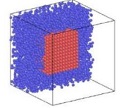Modeling of Ferrous Metal Diffusion in Liquid Lead Using Molecular Dynamics Simulation
DOI:
https://doi.org/10.19184/cerimre.v2i1.20561Abstract
Modeling of Iron metal diffusion in liquid lead using molecular dynamics simulation has been done. Molecular dynamics simulations are used to predict the value of physical quantities that we want to know based on the designed material model and on the input simulation data. In this research, effect of different geometry of material models was observed to know the diffusion coefficient. The material system was iron (Fe) in liquid lead (Pb). The material models is designed using Packmol software to get the initial configuration of atom's arrangement by inputting the material's characteristics such as mass, density, volume, number of atoms. This work examines the diffusion coefficient of iron in molten lead metal with the geometric shape of the simulation system in the form of iron in molten metal for various simulation models of boxes in a box, balls in a box and balls in balls. To design simulated geometric shapes we use the Packmol program. To calculate the diffusion coefficient we use the molecular dynamics simulation method. To find out which geometry is suitable, we compare the diffusion coefficient of the simulation results with existing references. The diffusion coefficient value of the spherical iron (Fe) system in the spherical liquid lead (Pb) has the best value compared to the other two forms with an accuracy rate of 99.94% because it is influenced by the even distribution of atoms in each part.








